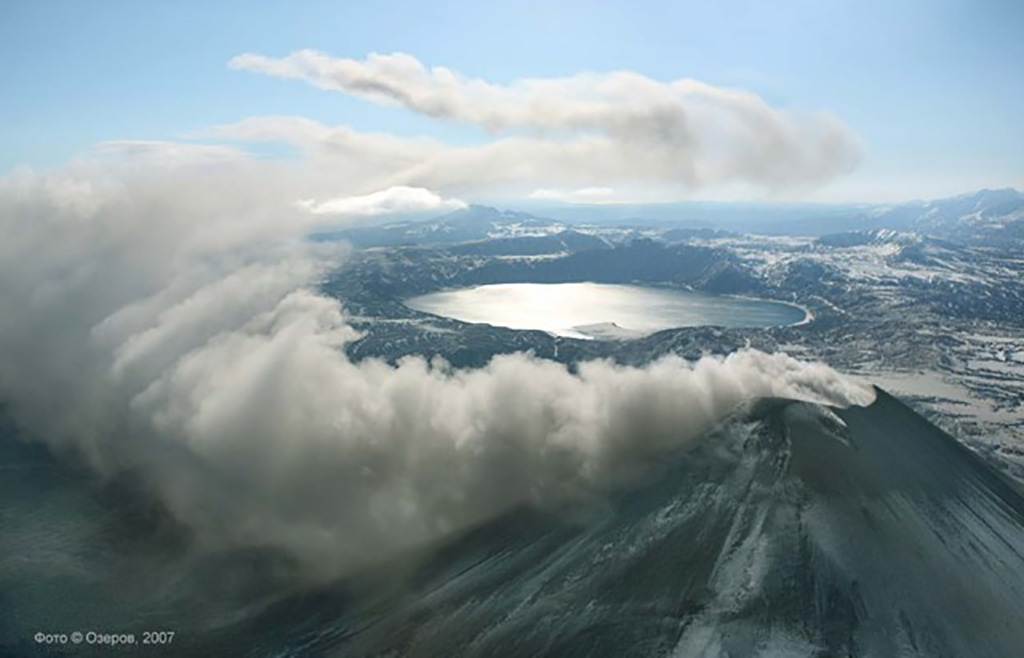Report on Karymsky (Russia) — July 2008
Bulletin of the Global Volcanism Network, vol. 33, no. 7 (July 2008)
Managing Editor: Richard Wunderman.
Karymsky (Russia) Ongoing explosions that began in 1996 continued through September 2008
Please cite this report as:
Global Volcanism Program, 2008. Report on Karymsky (Russia) (Wunderman, R., ed.). Bulletin of the Global Volcanism Network, 33:7. Smithsonian Institution. https://doi.org/10.5479/si.GVP.BGVN200807-300130
Karymsky
Russia
54.049°N, 159.443°E; summit elev. 1513 m
All times are local (unless otherwise noted)
Karymsky stratovolcano, one of most active of the Eastern Volcanic Zone of the Kamchatka arc, began an eruptive cycle in January 1996 lasting through at least September 2008. This report covers activity from June 2008 to September 2008 (figure 15).
 |
Figure 15. A photo from December 2007 showing a plume emerging from Karymsky's summit crater with lake-filled Academy Nauk caldera in the background. Photo by A. Ozerov. |
During June-September, there were alternating periods of strengthening and weakening activity. Ash plumes were emitted and hot avalanches repeatedly descended the flanks. Seismic events usually had local magnitudes (ML) less than 2.5. Local shallow earthquakes were associated with crater explosions. Satellite data registered thermal anomalies usually on the crater, suggesting the eruption of hot magmatic material such as a lava flow or fragmental avalanches. An increase in the anomaly to 4-7 pixels usually accompanied a lava flow. Code Orange days during the reporting period occurred on the following days (table 4).
Table 4. Thermal anomalies at Karymsky from NOAA-15 satellite images and visual observations for the interval from June to September 2008. Courtesy of Kamchatka Branch of the Geophysical Service of the Russian Academy of Sciences (KB GS RAS).
| Date(s) | Thermal Anomaly (pixels) | Comments |
| 27 Aug 2008 | -- | Local shallow earthquakes; ash plume 2.9-3.2 km altitude |
| 28 Aug 2008 | 4 | Local shallow earthquakes; ash plume 2.6-3.0 km altitude |
| 29 Aug 2008 | 4 | Local shallow earthquakes; ash plume 3.0-3.8 km altitude |
| 31 Aug 2008 | 1 | Local shallow earthquakes; ash plume 3.0 km altitude |
| 01 Sep 2008 | -- | Local shallow earthquakes; ash plume 3.3 km altitude |
| 08 Sep 2008 | -- | Local shallow earthquakes; ash plumes reaching 2.2-3.2 km altitude |
| 13 Sep 2008 | 2 | Local shallow earthquakes |
| 14 Sep 2008 | 2 | Local shallow earthquakes; ash plume 2.9 km altitude |
Geological Summary. Karymsky, the most active volcano of Kamchatka's eastern volcanic zone, is a symmetrical stratovolcano constructed within a 5-km-wide caldera that formed during the early Holocene. The caldera cuts the south side of the Pleistocene Dvor volcano and is located outside the north margin of the large mid-Pleistocene Polovinka caldera, which contains the smaller Akademia Nauk and Odnoboky calderas. Most seismicity preceding Karymsky eruptions originated beneath Akademia Nauk caldera, located immediately south. The caldera enclosing Karymsky formed about 7600-7700 radiocarbon years ago; construction of the stratovolcano began about 2000 years later. The latest eruptive period began about 500 years ago, following a 2300-year quiescence. Much of the cone is mantled by lava flows less than 200 years old. Historical eruptions have been vulcanian or vulcanian-strombolian with moderate explosive activity and occasional lava flows from the summit crater.
Information Contacts: Kamchatka Volcanic Eruptions Response Team (KVERT), Aleksey Ozerov, Institute of Volcanology and Seismology, Far East Division, Russian Academy of Sciences, Piip Ave. 9, Petropavlovsk-Kamchatsky, 683006, Russia (URL: http://www.kscnet.ru/ivs/); Kamchatka Branch of the Geophysical Service of the Russian Academy of Sciences (KB GS RAS), Sergey Senukov, Russia (URL: http://www.emsd.ru/).

